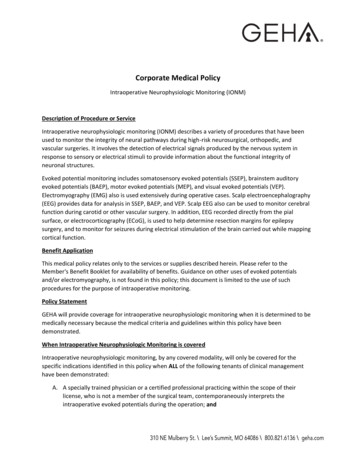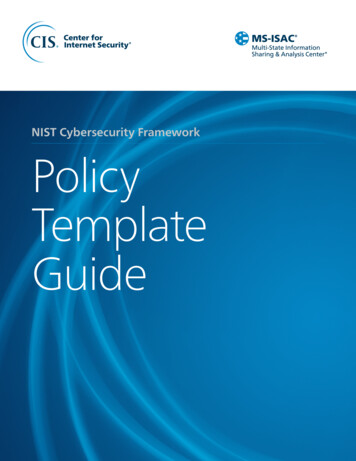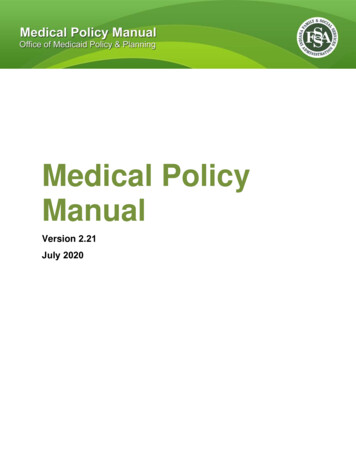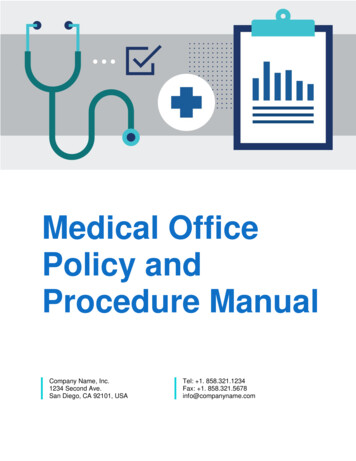
Transcription
Corporate Medical PolicyIntraoperative Neurophysiologic Monitoring (IONM)Description of Procedure or ServiceIntraoperative neurophysiologic monitoring (IONM) describes a variety of procedures that have beenused to monitor the integrity of neural pathways during high-risk neurosurgical, orthopedic, andvascular surgeries. It involves the detection of electrical signals produced by the nervous system inresponse to sensory or electrical stimuli to provide information about the functional integrity ofneuronal structures.Evoked potential monitoring includes somatosensory evoked potentials (SSEP), brainstem auditoryevoked potentials (BAEP), motor evoked potentials (MEP), and visual evoked potentials (VEP).Electromyography (EMG) also is used extensively during operative cases. Scalp electroencephalography(EEG) provides data for analysis in SSEP, BAEP, and VEP. Scalp EEG also can be used to monitor cerebralfunction during carotid or other vascular surgery. In addition, EEG recorded directly from the pialsurface, or electrocorticography (ECoG), is used to help determine resection margins for epilepsysurgery, and to monitor for seizures during electrical stimulation of the brain carried out while mappingcortical function.Benefit ApplicationThis medical policy relates only to the services or supplies described herein. Please refer to theMember's Benefit Booklet for availability of benefits. Guidance on other uses of evoked potentialsand/or electromyography, is not found in this policy; this document is limited to the use of suchprocedures for the purpose of intraoperative monitoring.Policy StatementGEHA will provide coverage for intraoperative neurophysiologic monitoring when it is determined to bemedically necessary because the medical criteria and guidelines within this policy have beendemonstrated.When Intraoperative Neurophysiologic Monitoring is coveredIntraoperative neurophysiologic monitoring, by any covered modality, will only be covered for thespecific indications identified in this policy when ALL of the following tenants of clinical managementhave been demonstrated:A. A specially trained physician or a certified professional practicing within the scope of theirlicense, who is not a member of the surgical team, contemporaneously interprets theintraoperative evoked potentials during the operation; and
B. The evoked potential monitoring is performed in the operating room by dedicated trainedtechnician; andC. The clinician who performs the interpretation may do so remotely, but must provide direct,immediate communication of intraoperative evoked potential results to the technician andsurgeon during the operation.GEHA considers intra-operative electromyographic (EMG) monitoring medically necessary for thefollowing indications when the required tenants of clinical management have been demonstrated:A.B.C.D.E.F.G.H.I.J.K.L.Surgical excision of neuromas of the facial nerveSurgery for cholesteatoma, including mastoidotomy or mastoidectomySurgery for acoustic neuroma, congenital auricular lesions, or cranial base lesionsVestibular neurectomy for Meniere's diseaseMicrovascular decompression of the facial nerve for hemifacial spasmDuring selective dorsal rhizotomyBrachial plexus surgeryCauda equine tumorNerve root tumor (schwannoma)Vestibular schwannoma surgeryTethered cord releaseExcision of neuromas of:1. Abducens nerve2. Glossopharyngeal nerve3. Hypoglossal nerve4. Oculomotor nerve5. Recurrent laryngeal nerve6. Spinal accessory7. Superior laryngeal nerve8. Trochlear nerveGEHA considers intra-operative somatosensory evoked potentials (SSEPs) performed either alone, orin combination with motor evoked potentials (MEPs) as medically necessary for monitoring theintegrity of the spinal cord to detect adverse changes before they become irreversible during certainspinal, intracranial, or vascular procedures including the following:Spinal Surgeries:A.B.C.D.E.Correction of scoliosis or deformity of the spinal cord involving traction on the cordDecompression of the spinal cord where function of the spinal cord is at riskRemoval of spinal cord tumorsSurgery as a result of traumatic injury to the spinal cordSurgery for arteriovenous (AV) malformation of the spinal cordIntracranial Surgeries:Origination Date: Feb. 2016Peer Reviewed: Jan 2021Next Review Date: Jan. 2022
A.B.C.D.E.F.G.H.I.J.K.L.M.N.Chiari malformation surgeryCorrection of cerebral vascular aneurysms (e.g., cerebral aneurysm clipping)Deep brain stimulationEndolymphatic shunt for Meniere's diseaseMicrovascular decompression of cranial nerves (e.g., optic, trigeminal, facial, auditory nerves)Oval or round window graftRemoval of cavernous sinus tumorsRemoval of tumors that affect cranial nervesResection of brain tissue close to the primary motor cortex and requiring brain mappingResection of epileptogenic brain tissue or tumorSurgery as a result of traumatic injury to the brainSurgery for intracranial AV malformationsSurgery for intractable movement disordersVestibular resection for vertigoVascular Surgeries:A. Arteriography, during which there is a test occlusion of the carotid arteryB. Circulatory arrest with hypothermia (does not include surgeries performed under circulatorybypass such as CABG, and ventricular aneurysms)C. Distal aortic procedures, where there is risk of ischemia to the spinal cordD. Surgery of the aortic arch, its branch vessels, or thoracic aorta, including carotid artery surgery(e.g., carotid endarterectomy), when there is risk of cerebral ischemiaGEHA considers that intra-operative somatosensory evoked potentials (SSEPs) performed eitheralone, or in combination with motor evoked potentials (MEPs) may be medically necessary formonitoring the integrity of the recurrent laryngeal nerve in patients undergoing:High-risk thyroid or parathyroid surgery, including:A. Total thyroidectomyB. Repeat thyroid or parathyroid surgeryC. Surgery for cancerD. ThyrotoxicosisE. Retrosternal or giant goiterF. ThyroiditisAnterior cervical spine surgery associated with any of the following increased risk situations:A. Prior anterior cervical surgery, particularly revision anterior cervical discectomy and fusion,revision surgery through a scarred surgical field, reoperation for pseudarthrosis or revisionfor failed fusionB. Multilevel anterior cervical discectomy and fusionC. Pre-existing recurrent laryngeal nerve pathology, when there is residual function of the recurrentlaryngeal nerve.When Intraoperative Neurophysiologic Monitoring is not coveredOrigination Date: Feb. 2016Peer Reviewed: Jan 2021Next Review Date: Jan. 2022
GEHA considers intra-operative EMG monitoring experimental/investigational for the followingindications, including but not limited to:A. During spinal surgery (including for anterior cervical, except as noted above) because there isinsufficient evidence that this technique provides useful information to the surgeon in terms ofassessing the adequacy of nerve root decompression, detecting nerve root irritation, orimproving the reliability of placement of pedicle screws at the time of surgery (Garces, J. et. al.,2014).B. During laryngeal nerve monitoring during parathyroid and thyroid surgery, except as notedabove (Hermann, M., Hellebart, C., & Freissmuth, M., 2004).C. During hip replacement surgery (Hesper, et. al., 2017).D. During decompression, neurectomy, radiosurgery or rhizotomy of the trigeminal nerve (Bajwa,Z., Ho, C., & Khan, S., 2015).GEHA considers intra-operative EEG monitoring experimental/investigational for the followingindications, including but not limited to:A. Intraoperative EEG for open-heart surgery (Gelinas, J. et. al., 2013).B. All other indications (e.g., prediction of post-operative delirium)GEHA considers GEHA considers intra-operative SSEPs with or without MEPsexperimental/investigational for indications not listed above including, but not limited to:A. Intraoperative BAER during stapedectomy, tympanoplasty and ossicle reconstruction;B. Intraoperative MEP during implantation of a spinal cord stimulator;C. Intraoperative neuromonitoring during adjustment of vertical expandable prosthetic titaniumD.E.F.G.rib;Intraoperative saphenous nerve somatosensory evoked potential for monitoring the femoralnerve during trans-psoas lumbar lateral interbody fusion;Intraoperative SSEP of the facial nerve for submandibular gland excision or parotid glandsurgery, during hip replacement surgery, implantation of a spinal cord stimulator, off-pumpcoronary artery bypass surgery, and for thyroid surgery and parathyroid surgeryIntraoperative SSEP, with or without MEPs, for cochlear implantation, decompression of thetrigeminal nerve, implantation of vagus nerve stimulator, monitoring spinal injections (e.g.,epidural injections, facet joint, interlaminar and transforminal epidural), open reduction internalfixation (ORIF) of the finger, radiofrequency ablation of facet medial branch, rotator cuff repair,or wrist arthroscopy repair;Intraoperative visual evoked potentials (e.g., for pituitary surgery, during intra-cranial surgeryfor arterio-venous malformation);GEHA considers intraoperative neurophysiologic monitoring of the recurrent laryngeal nerve duringanterior cervical spine surgery not meeting the criteria above or during esophageal surgeries tobe investigational.GEHA considers EMG monitoring and neuromuscular junction testing during spinal surgery (includinganterior cervical procedures) to be experimental and investigationalOrigination Date: Feb. 2016Peer Reviewed: Jan 2021Next Review Date: Jan. 2022
GEHA has determined that intra-operative evoked potential studies have no proven value for lumbarsurgery below (distal to) the end of the spinal cord; the spinal cord ends at L1-L2GEHA considers intraoperative monitoring of motor-evoked potentials using transcranial magneticstimulation investigational.GEHA considers intraoperative EMG and nerve conduction velocity monitoring during surgery on theperipheral nerves not medically necessary.Policy GuidelinesIntraoperative monitoring typically is done in the operating room by a technician, with a physician as aremote backup. In some operating rooms there is a central physician monitoring room, where aphysician may simultaneously monitor several cases. Constant communication between surgeon,neurophysiologist, and anesthetist is required for safe and effective intraoperative neurophysiologicmonitoring.IONM codes are reported based upon the time spent monitoring and not on the number of testsperformed or parameters monitored. In addition, time spent monitoring excludes preparation,administration and interpretation times for baseline studies. Time spent performing or interpreting thebaseline neurophysiologic studies should not be counted as intraoperative monitoring; these areseparately reportable procedures.Operating rooms typically have equipment that emits electromagnetic interference, which is greatest atthe frequency of alternating current (60 Hz in the United States). It is recognized that such interferencecan impact the data obtained via neurophysiologic monitoring and appropriate steps by the responsiblefacility to mitigate the impact of this phenomenon on clinical outcomes are required.In 2009 the American Clinical Neurophysiology Society published recommended standards forintraoperative neurophysiologic monitoring. Guideline 11A includes the following statement:“The monitoring team should be under the direct supervision of a physician with training andexperience in NIOM (Neurophysiologic Intraoperative Monitoring). The monitoring physician should belicensed in the state and privileged to interpret neurophysiologic testing in the hospital in which thesurgery is being performed. He/she is responsible for real-time interpretation of NIOM data. Themonitoring physician should be present in the operating room or have access to NIOM data in real-timefrom a remote location and be in communication with the staff in the operating room. There are manymethods of remote monitoring however any method used must conform to local and national protectedhealth information guidelines. The monitoring physician must be available to be in the operating room,and the specifics of this availability (i.e., types of surgeries) should be decided by the hospitalcredentialing committee. In order to devote the needed attention, it is recommended that themonitoring physician interpret no more than three cases concurrently.”American Board of Registration of Electroencephalograpic and Evoked Potential Technologists (ABRET)has established guidelines for proper credentialing of the IONM professional. Although there are anumber of different pathways, the candidate must have performed at least 150 surgical monitoringcases, passed a written examination, and hold either a bachelor's degree or another credential inneurodiagnostics such as the R.EEG.T or R.EP.T (registered EEG or EP technologist). Gertsch et. al.Origination Date: Feb. 2016Peer Reviewed: Jan 2021Next Review Date: Jan. 2022
(2019) go on to outline the responsibilities of the IONM-P: In order to optimize patient care and safety,the IONM-Physician must remain continuously available to perform intraoperative responsibilities in realtime throughout the procedure. Retrospective, or ‘‘after-the-fact’’ interpretation and reporting, is ofnegligible benefit to the patient or the surgeon. The IONM-Physician:1. Supervises all technical aspects of IONM to ensure overall patient safety and quality of care.2. Communicates and collaborates with other members of the patient care team3. Interprets IONM data:(a)Evaluates the quality and consistency of baseline data and identifies abnormalities in thecontext of known variables.(b)Evaluates IONM data in the context of the procedure and takes into account patient vitals,imaging and labs when available and appropriate.(c)Evaluates and interprets data obtained from topographical/neuro-navigation studies.4. Develops a differential diagnosis:(a)Determines the significance of changes from baseline data. To the extent possible,determines if changes are related to iatrogenic injury, anesthetic effects, physiological variables,patient positioning, technical factors, or a combination of these.(b)Recommends assessment technique(s) most appropriate to answer anatomic, functional, orprognostic questions related to specific neural structures.5. Provides input to the patient care team to help develop and execute a plan of therapeuticintervention to recover neural function when an adverse alteration in IONM data presents.The IONM technician is responsible for collaborating with the IONM Physician; relaying data that mayindicated a need for intervention.In 2013, The American Society of Neurophysiological Monitoring released a position statementrecommending specific guidelines for IONM including medications to use, wave length specificationsand qualifications for personnel.The American Academy of Neurology concluded that IONM is established as effective for predictingincreased risk of adverse outcomes such as paraparesis, paraplegia and quadriplegia during spinalsurgery. Surgeons and other members of the operating team should be alerted to the increased risk ofsevere adverse neurological outcomes in patients with important IONM changes. Furthermore, therewas insufficient evidence to evaluate IOM conducted by automated devices or technicians without thesupervision of a clinical neurophysiologist experienced with IONM.American Association of Neurological Surgeons (AANS) and the Congress of Neurological Surgeons(CNS)(2014): The position of the AANS/CNS is that IOM should be performed in procedures when theoperating surgeon feels that the diagnostic information is of value. Such procedures include: deformitycorrection, spinal instability, spinal cord compression, intradural spinal cord lesions, and navigating inproximity to peripheral nerves or roots. AANS/CNS also recommends the use of spontaneous andOrigination Date: Feb. 2016Peer Reviewed: Jan 2021Next Review Date: Jan. 2022
evoked EMG for minimally invasive lateral retroperitoneal transpsoas approaches to the lumbar spine,and may also be of utility during pedicle screw insertion.Physician documentationA. The medical record must contain evidence that fully supports the medical necessity criteria listedwithin this policy for IONM. This documentation includes, but is not limited to, relevant medicalhistory, physical examination, the anatomic location of the planned surgical procedure, the rationalefor the location and modalities to be monitored, and results of pertinent diagnostic tests orprocedures.B. Operative report (Post-procedure)C. Intraoperative neurophysiologic monitoring report (Post-procedure)D. Intraoperative neurophysiologic monitoring should not be reported by the physician performing anoperative or anesthesia procedure since it is typically included in a global package.BackgroundThe principal goal of intraoperative neurophysiologic monitoring (IONM) is the identification of nervoussystem impairment on the assumption that prompt intervention will prevent permanent deficits.Correctable factors at surgery include circulatory disturbance, excess compression from retraction, bonystructures, hematomas, or mechanical stretching.Sensory-evoked potential describes the responses of the sensory pathways to sensory or electricalstimuli. Intraoperative monitoring of sensory-evoked potentials is used to assess the functional integrityof central nervous system (CNS) pathways during surgeries that put the spinal cord or brain at risk forsignificant ischemia or traumatic injury. The basic principles of sensory-evoked potential monitoringinvolve identification of a neurological region at risk, selection and stimulation of a nerve that carries asignal through the at-risk region, and recording and interpretation of the signal at certain standardizedpoints along the pathway. Sensory-evoked potentials can be further categorized by the type ofstimulation used: Somatosensory-evoked potentials (SSEP), Brainstem auditory-evoked potentials(BAEP) and Visual-evoked potentials (VEP) (Liem & Benbis, 2016).Motor-evoked potentials (MEPs) are recorded from muscles following direct or transcranial electricalstimulation of motor cortex or by pulsed magnetic stimulation provided by a coil placed over the head.Peripheral motor responses (muscle activity) are recorded by electrodes placed on the skin at prescribedpoints along the motor pathways. Motor evoked potentials, especially when induced by magneticstimulation, can be affected by anesthesia.Transcranial motor evoked potentials MEP involve applying a train of high-voltage stimuli to electrodeson the surface of the head to activate motor pathways and produce either a motor contraction (muscleMEP) or a nerve action potential (D-wave) that can be recorded. This process can be performed in theawake patient (Stecker, M., 2012).Electromyogram (EMG) monitoring and nerve conduction velocity measurements can be performed inthe operating room and may be used to assess the status of the cranial or peripheral nerves, e.g., toidentify the extent of nerve damage prior to nerve grafting or during resection of tumors. In addition,Origination Date: Feb. 2016Peer Reviewed: Jan 2021Next Review Date: Jan. 2022
such techniques may be used during procedures around nerve roots and/or peripheral nerves to assessfor excessive traction or other impairment. In these procedures, monitoring is done in the directionopposite that of sensory-evoked potentials, but this still supports verification that the neural pathway isintact.Electroencephalogram (EEG) monitoring is also employed as a mode of monitoring neural functionduring certain types of surgery. This includes use of intraoperative scalp monitoring ofelectroencephalogram activity, as well as grid monitoring or electrocorticography (ECoG). ECoG isrecording of the EEG directly from a surgically exposed cerebral cortex and is primarily used
G. Brachial plexus surgery H. Cauda equine tumor I. Nerve root tumor (schwannoma) . remote backup. In some operating rooms there is a central physician monitoring room, where a . In order to optimize patient care and safety, the IONM-Physician must remain continuously ava










